Welcome to the seventh drop of my newsletter! This week’s essay is called “Slow Consumption.” I’ve decided to try a new format to my newsletter. I’m going to try presenting my essay in full, and then carry on with the rest of my findings.
“Cool Shit I Found” is a series where I create a highlight reel of cool stuff I’ve come across in the past week or just in general. I hope that this newsletter will inspire meaningful conversations and connections. As always, thanks for joining me on this journey of exploration and self-discovery.
This newsletter is broken up into the following:
I. Slow Consumption
II. Essays I’ve read + Visual Art + Media
III. Music I’ve been listening to
I. Slow Consumption
by me
My eyes wearily open simultaneously as I begin to recognize a consuming grogginess. I should jolt out of bed. I should go and wash my face. But instead I stop my ringing alarm that sings Apple’s melodic “Radar” — banger btw — and immediately hop onto one of the 3 digital opiates: Instagram, Twitter, or Tiktok. There’s a chain reaction that occurs that leads me to hop to the other 2 platforms when I’m not getting the hit I need from the one I’m on. I swipe up, pick a screen that I think will fulfill my dopamine needs, and I rinse and repeat.
This is a familiar opening in more than one sense. Every article that decries the destructive effects of social media on the attention span will start out with the same case study, and then proceed to make the obvious sanctimonious argument that we should cut back in somehow our consumption. The solutions dating back to the early-mid 2010’s to address the social media addiction are usually to introduce some sort of stop gap. Change your screen colors to black/white, use the ScreenTime app, put your phone in another room besides the one you’re working in, and the list goes on.
Now we are in the 2020’s and social media (generally screen) addiction is still a problem. And addictions are physiologically entrenched habits. To fight an addiction is to rewire one’s brain. To rewire one’s brain is to create an alternative incentive structure. However, the nature of the beast we’re fighting has since evolved from the 2010’s. Nowadays, logging onto an app is the equivalent of hooking up a fire hose right into your brain. Feeds are no longer restrained to our inner circles, and neither is engagement. Tiktok’s advancements in leveraging machine learning in optimizing their recommendation algorithms have made things so efficient that when their “For You” tab says “For You,” oh boy do they fucking mean it. Moreover, Instagram, Twitter, and even Youtube have took note of these advancements and have sought to implement the same “lets the dogs out into their brains” strategy. Suffice it to say we’ve come a long way from Musical.ly.
To win back our attention from our evolved enemy is to take a step back and champion a new standard. Because that’s the resource at stake at the end of the day, right? Attention. But there’s something else that’s correlated to our attention that is also at stake. It’s our sense of agency. What we’re really lacking nowadays is the ability to consume stuff on our own terms. Within seconds of being on TikTok it tunes itself to the tastes of your national, regional, city, gender, religion, and ethnic demographics if not more but certainly with the combination of 2 or more of them. Eventually it gets so good, you find yourself hearing an oft-written comment: “My ForYou page really said ForYou.” The content you’re being served is so good, why else would you go anywhere else? Why else would you even want to do something else? If your friends don’t see you, somewhere amidst the 1.53 billion + users there’s the promise of finding your peoples.
Of course the common critique against critique of the banality of evil that Tiktok presents itself as is that you can train an algorithm. By searching for certain content, by clicking “Not Interested,” saving this or that, you can eventually curate and reset your feed to your heart’s content. So if your “For You” page is too unhinged, too professional, or too funny, the onus is on you to course correct. However, is that fair? To tune the algorithm is to spend conscious time thinking carefully of whether or not you want to choose to consume a piece of content or something like it. Then it requires you to take a course of action by explicitly clicking the “share” button first, and then amidst a bunch of other options you may find the “not interested” button. lol.
Tiktok works best when you are a vegetable scrolling through, and it makes it hard to be a conscious consumer. In fact, if everyone were to consciously consume would there be much more incentive to unconsciously produce? Tiktok’s ability to curate to your exact liking because it’s also trivially easy to produce, and to produce quickly at that. The templates, trends, and audios all seemlessly integrate into one another.
Ok so what? Should we just throw our phones out at this rate?
Yes.
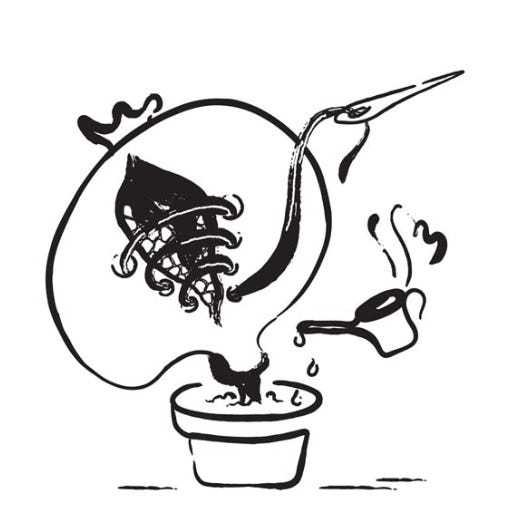
Slow Consumption. We begin to champion for ourselves and others content that we’ve actually digested and sat with. That when we set aside time in our busy days to say “I know I want to be a vegetable right now, but I want to take 5-10 minutes to really feel what I’m consuming.” And it doesn’t have to be all that deep. You find a tweet, an IG post/story, or a Tiktok funny? Ask yourself, funny how?
Consume and produce consciously. That literally boils down to keeping track of exactly what you’re putting out into the world and what’s being put in your mind. This doesn’t have to go off into some Illuminati discourse. It could literally be you telling yourself “oh I think farming is really cool, and I love Tiktoks where I see happy cows!” Awesome! You’ve began the steps toward conscious consumption. You may start out with simply resetting your feed so you see more cute animals. Then, as a step further, you could dig deeper. Perhaps create a newsletter or some form of content to do with cute animals.
Why create? Because the act of creation slows consumption by definition. To be able to create means you must switch off the consumption part of your brain. You can’t produce and absorb at the same time, it’s an either or proposition. But by creating a distinction between times of consumption and times of creation, you naturally begin to consume more intentionally. You begin to look for and discover that which you aspire to create. The path of the craftsman, the artist, the builder, the designer, the musician and all the like requires a type of awareness that there is art that you enjoy, that motivates, and that which serves as a muse. If there is a benefit to TikTok and the newly evolved social media realm is that it also provides you the tools to be a creator/builder/artist/musician ASAP. It’s shown the average person that they don’t have to be an expert in something, that they could simply do things for the fun of it.
Many of the ancient traditions treat our sensory outputs as gateways to our souls. And if these pathways are left unregulated, they naturally devolve into what is easy and convenient. Slow consumption, I hope, gives us the digital equivalent of cultivating our own digital gardens. Our identities today are interwoven between the physical and digital. Consequently, and as obvious as this sounds, our digital experience informs our physical reality as much as the inverse is true. We owe it to ourselves to regulate the pathways to our souls. Who are these entities that we’ve allowed to hook up an IV drip of soulless content straight into our souls? It’s time to take back control over how we feel, how we think, how we laugh, how we hate, and how we love.
II. Essays I’ve read + Visual Art + Media
The Way We Live Now: 11-11-01; Lost and Found by Colson Whitefield
The big homie in NYC Asad put this on his IG story and there was a particular passage that struck me so I decided to read the entire article. I found this other excerpt that hit me too, and, while specific to NYC especially with reference to the twin towers, I think this applies generally to living in any big city. What it has me thinking about is the concept of “placemaking” which a friend brought up to me for her next photo essay. Hope you reflect on what placemaking means for you as you read this article.
Shahzoda.Dev
My homie Shahzoda is back on CSIF with another feature because of her lovely and intentional website. Seeing this really inspired me to really just create something hyper-intentional and true to myself. I feel like this website she has made is a great example of the “creating” aspect I bring up in slow consumption.

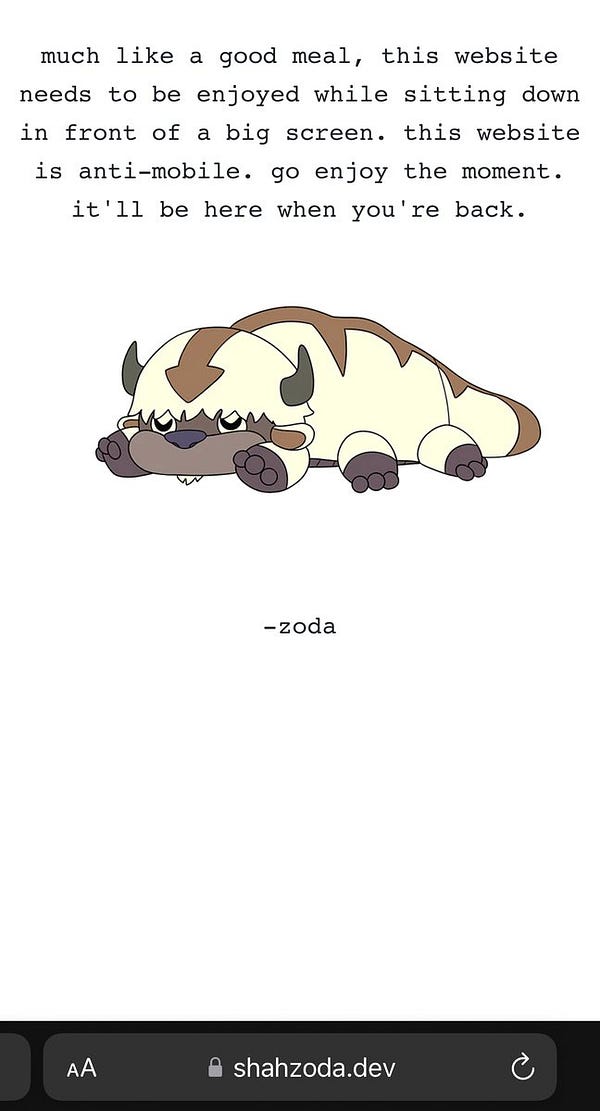
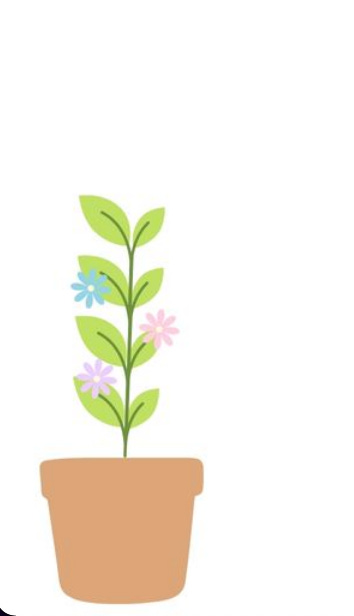
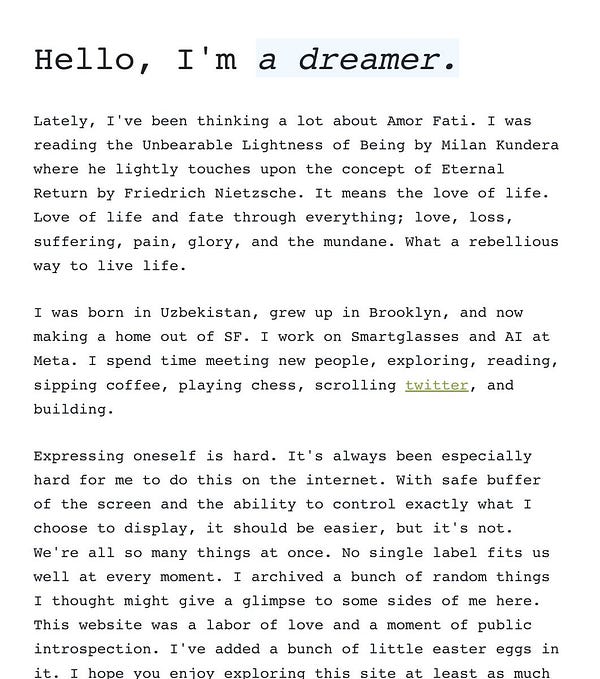
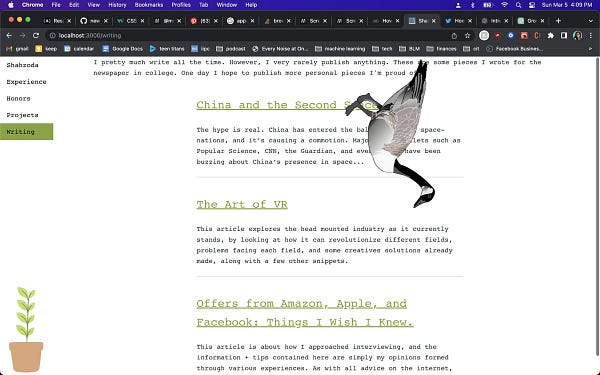
III. Music I’ve Been Listening To
If there’s any album I can recommend you to listen to, in full, ASAP is the BLK VINTAGE album by BLK Odyssey.
Thanks for reading this edition. Hope this new format worked out for you. Share this with your friends, your grandma, or your neighbor. And if you made it to the end of this essay and you didn’t just scroll, dm me a 🐬 on either twitter or instagram. or leave a comment! As always,
Sincerely,
Haroon
P.S. Check out my previous newsletter if you’re curious: Cool Shit I Found #6








